People tell you to eat your vegetables, but they don't tell you how. My strategies + recipes (part 1)
+ Zoom cooking class recap
Hello everyone!
It’s been exactly one week since my first online cooking class. How was it? We had some initial tech challenges, but as a group, we figured them out! 😮💨
People attended from all over the States, and there were also folks from Mexico, Canada and France! Some cooked along while others observed and learned. A recording went out afterward later so everyone who signed up has the playback. We had a blast! Thanks to all who shared tips and instant feedback.

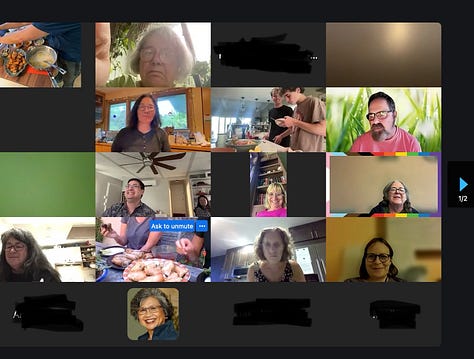



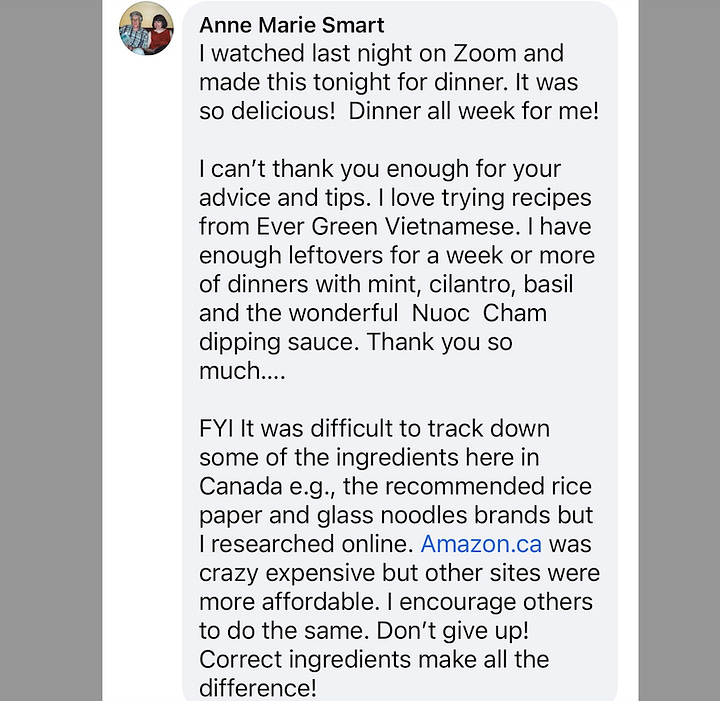

Coming up next: A bunch of people have already signed up for classes focusing on Viet street food and Chinese dim sum (9/15) and wontons and siu mai (9/29). There are options for omnivores and vegans in both classes.
Think about taking these classes because I’d love to cook with you! (If you’re a paid subscriber, use your special 20% discount code.)
I felt fabulous after class but by the end of this week, Rory and I both got Covid-19. (It likely came from a professional function Rory attended). We’re feeling kinda low and cancelled plans to go to Hawaii this week.
However, I’d been planning on answering Erin’s question, one that can drag anyone down in the kitchen:
How to (painlessly) cook and eat more vegetables
Unlike Erin, we are a household of two adults with flexible schedules. However, Rory and I mostly eat at home. Three times a day. Breakfast is on autopilot because we each have our set routines, but lunch and dinner are on me.
I love my husband, but he knows that I struggle to consistently make something healthy and tasty for our midday and evening meals. When Rory is surprised, he says, “That was delicious!” I respond with victory arms. Seriously. #nguyenwin!
To help Erin (and perhaps many of you out there), I’ve been taking notes on how I shop, prep and cook. I’ve identified some recurring patterns and developed approaches that work for us as we retreat from eating meat.
Let veggies creep in
Start with the possible and congratulate yourself as you graduate to what may have seemed impossible. Initially commit to 1 or 2 vegetarian meals daily. When you’re ready, try 1 or 2 fully vegetarian days a week.
For four years, I aimed for breakfast and lunch to be vegetarian. I wasn’t 100% consistent with that goal. I viewed it as a practice or game, not self-flagellation. Dinner always involved seafood or meat on some level.
But about six weeks ago, I (boldly) fed us an entire day of vegetarian food. Refried adzuki beans, brown jasmine rice, stir-fried veggies. (The sweet potatoes were prep. Keep reading.)
Before bed, we asked ourselves: How do we feel afterward? Satisfied, light, good. Should we try this again? Sure, let’s see what happens. Can we do this 2, 3 or 4 days in a row? Maybe, maybe not, but we understand the benefits.
The effect wasn’t like I got rid of my post-menopause skin issues or hair regrew on Rory’s head. We simply felt a greater sense of wellbeing. I began planning more vegetarian dinners. When we did eat a steak, grill chicken, or fish, we ate a lot less before feeling satisfied.
None of this happened overnight.
Shop to cook fast & slow
No matter your household size, meal planning starts at the store, farmer’s market, online — wherever and however you buy food ingredients. About 50 to 75 percent of our weekly vegetables are ones that cook fast or require no cooking at all.
Right now, we’ve got lots of seasonal stars: summer squash, eggplant, green beans, corn, lettuce, cucumber, and tomatoes. The first four need cooking (stir-fry or grill), the latter three are for raw enjoyment (wash/cut, season, and eat). I load up on a lot because of my recipe development work, but for a home cook, focus on 3 seasonal stars a week and see what you can do with them.
Leafy greens (chard, kale, cabbage) always figure into the mix. Whatever greens that are on sale, be all in. They cook fast (steam-saute, stir-fry, drop into broth) or can be eaten raw (slaw or other form of salad). Buy 2 bunches of leafy greens because they collapse down to little when cooked. One head of cabbage is enough and will last for a month if you get a big, heavy one.
Stalwarts that I always keep on hand: carrots, celery, potatoes, yellow onion, garlic, and ginger. These ingredients can hold for a long time and can be used in fast or slow dishes.
Recipes mentioned below are in this newsletter (for free or paid subscribers), on my website, or in my books, which you may already have.
Lean into a “bean of the week”
For a versatile, fiber-rich, high protein option, prep one bean a week. My fallback is one of these two:
Pan-fry 2 pounds of tofu as slabs, cubes, or logs for sandwiches, stir-fries, soup, and salad. Shaking tofu ( from Vietnamese Food Any Day, page 149) is one of my summer go-tos. So is tofu with green onions, a Hanoi ditty that comes together in minutes. Asian recipes often call for deep-fried tofu but this pan-fried version is a tasty, low-fat and easy option for enjoying tofu. It’s a great nibble out of hand or dipped in soy sauce.
Cook 1 pound of dried beans to use throughout the week. I soak my beans overnight in the pot they’re going to cook in, then simmer them the next day in lightly salted water with kombu (dried kelp), ginger, onion and garlic. Beans cook at different rates of time so I prefer a stovetop simmer in a donabe or Dutch oven because I can monitor the beans’ progress. Use a slow cooker or pressure cooker (Instant Pot), if you like.

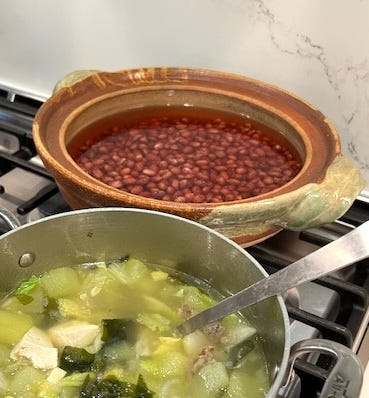
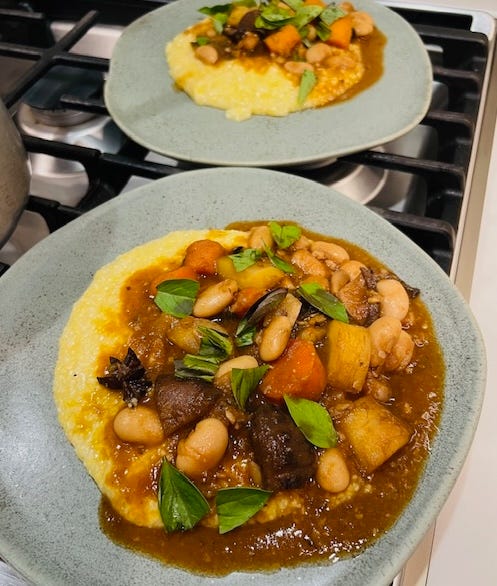
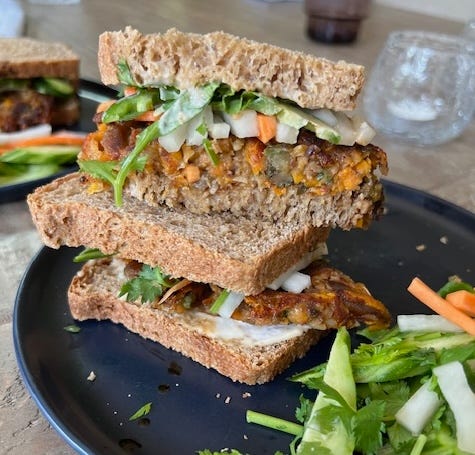
Shaking tofu, beans soaking while brothy soup simmers (dashi, tofu + lingering cabbage and chard); bo kho-style mushroom and white bean stew; and white bean smashed burger banh mi!
Adzuki beans got turned into refried beans which then served as the foundation for a bean burger mixture that I fried up into crisp smashed patties for burgers and salads. Adzuki beans can be used for hummus and Viet sweet dessert soup, too.
White beans were featured in a vegan take on Viet bo kho beef stew (recipe on page 224 in Ever-Green Vietnamese). I served the stew with bread, over grits, with tortillas. Leftovers got mashed and mixed with extra cooked beans, grated carrot and brown rice to create a bean burger mixture. I used it for the above pictured smashed bean burgers banh mi; yup, it’s ok to use sliced wheat bread for Vietnam’s iconic sandwich.
My favorite bean sources: Staff of Life (in Santa Cruz, CA), Rancho Gordo, and Camellia Brand.
Our meals are not perfect. But, when there’s some strategy and a divide and conquer approach, we eat satisfying food to get us from one meal to the next.
One final note on the universe . . . on Friday, in a Duolingo language session, I had to translate this sentence twice:


How to say 👆? I made this audio for you.
As always, I welcome your insights, comments and questions. Part 2 next week.






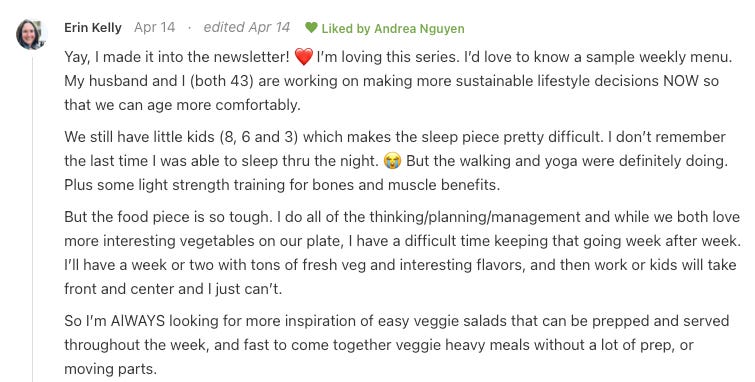
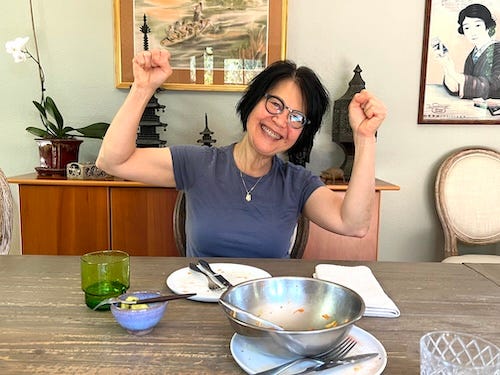
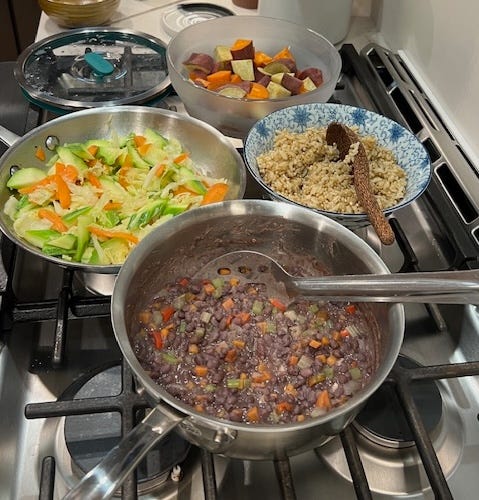


What a great title, Andrea! “They don’t tell you how!”
Class was FABULOUS!!! And I love the mini language lesson here! 🙏thank you.